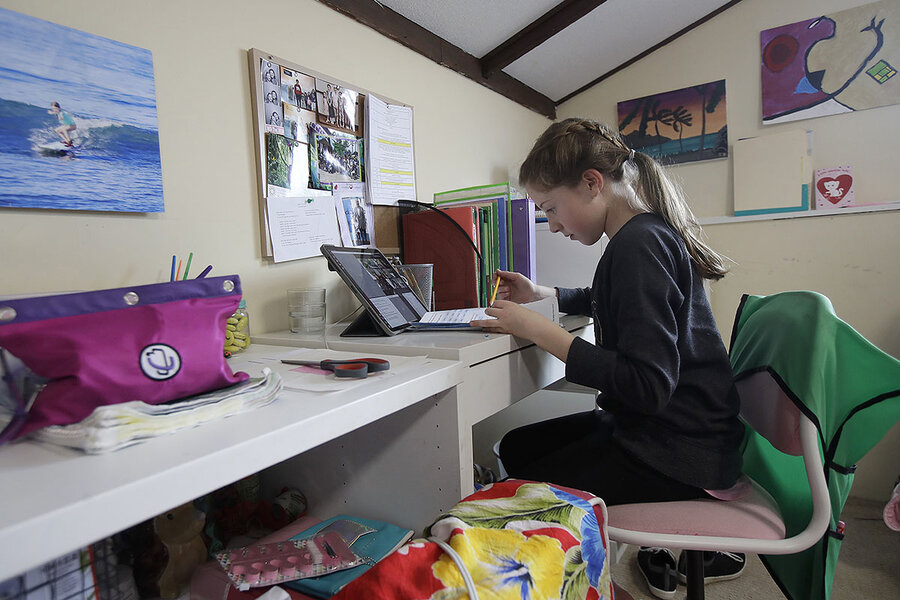What will it take to get kids back to class? Three questions.
Loading...
What will K-12 schools look like when their doors eventually reopen? Education leaders in the United States are planning multiple options for the fall, ranging from all students returning to buildings to continuing fully remote learning. What schools decide will vary based on guidance from local and state officials. Various approaches are already being seen as some schools reopen in Europe. France has already had to reclose some schools. A number of issues will inform the decisions of school officials.
How will K-12 schools look different when they reopen?
Promoting social distancing, hygiene, and heightened cleanings are top priorities for schools. A report on reopening from the American Enterprise Institute, a Washington think tank, recommends face masks worn by staff and students, frequent temperature checks and hand-washing, and desks placed 6 feet apart. This week, the Centers for Disease Control and Prevention in the U.S. also updated suggestions for schools. Other ideas include lunch in classrooms, closed playgrounds, and no all-school assemblies.
Why We Wrote This
When will students return to school buildings? Educators are still weighing that, keeping in mind that polls suggest parents want health risks eliminated. What K-12 education might look like in the fall is starting to take shape.
“I think the real question is what will [students and staff] not find changed,” says Robert Hull, president and CEO of the National Association of State Boards of Education.
Editor’s note: As a public service, all our coronavirus coverage is free. No paywall.
Curtis Jones, superintendent of the Bibb County Public School District in Macon, Georgia, which serves about 21,000 students, says he’s planning on various scenarios for schools to reopen in August, including students coming to school for two or three days and learning remotely the other days, as well as developing a full online curriculum for students who choose not to return. He thinks some students will return full time, but classes will be smaller.
“I see this as a transition period,” says Dr. Jones. “I think this will give us an opportunity to make a transition to the next phase of what public education looks like.”
In Reno, Nevada, schools in Washoe County School District will see more frequent cleanings, protective equipment for all employees, hand sanitizer stations, and social distancing measures once reopened, says Superintendent Kristen McNeill. She’s also considering installing plexiglass in front offices and additional buses to space out kids in the district of about 64,000 students.
Will remote learning continue?
Remote learning plays a key part in reopening plans and public education going forward, educators say. The Maryland State Department of Education recovery plan, for instance, suggests options such as alternating weeks of in-person and remote instruction.
One key concern is that millions of students who lack access to devices and the internet could be left out of remote learning.
“Home internet access for every student has to be a given moving forward, otherwise this remote learning will not work and we essentially will be denying many children their free, appropriate education which they are entitled to in this country,” says Susan Enfield, superintendent of the Highline Public Schools district in Burien, Washington, just south of Seattle.
Dr. Enfield estimates 2,500 students in her district are still without internet connectivity and calls it the biggest barrier for remote learning, which she believes will be a part of how schools operate going forward.
Staff in the district are working with teachers and families to find out what has worked and what needs to be changed with remote learning and are developing plans to have more “synchronous” remote learning in the future where teachers and students are online together for a class session.
How will schools accommodate varying comfort levels?
School leaders acknowledge that many parents and school staff may not feel comfortable returning to school under social distancing guidelines, or without a COVID-19 vaccine.
An early May poll of 500 parents from the National Parents Union found that 67% supported keeping schools closed until officials are certain reopening won’t pose a health risk. Many teachers, janitors, bus drivers, and other school staff are above the ages considered higher risk and teachers unions have cautioned against opening schools too soon.
Dr. Jones says schools in Bibb County have technology in all classrooms, so there are ways for teachers to join students from a remote location while a substitute is in the classroom. That option for at-risk educators was also included in a plan published in late April by one union, the American Federation of Teachers. Washoe County School District already runs a virtual K-12 school and Dr. McNeill is considering expanding its capacity.
Mr. Hull, of the school board association, recommends school leaders ask parents and community members what their biggest concerns are and work together toward finding solutions. “There’s a lot of fear and a lot of concern,” he says, “and the way you handle that is by being methodical, by being strategic, and being open and transparent and including everyone in the conversation.”
Editor’s note: This story has been updated to include the latest guidance from the Centers for Disease Control and Prevention. As a public service, all our coronavirus coverage is free. No paywall.






